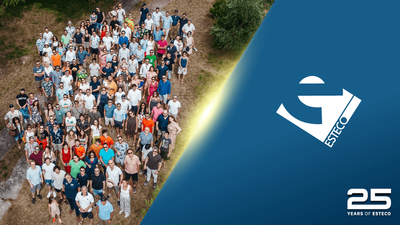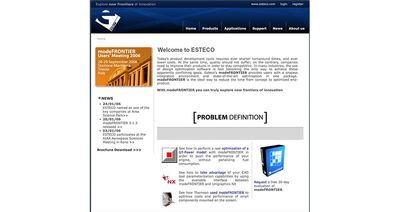From startup to global player in 25 years: embracing change and fostering creativity
Written by Paolo Vercesi and Sergio Benedetti
30 May 2024

Looking back on ESTECO’s 25 years in business, the question arises: what does it take to grow from a three-person startup to a global company? It’s not just a matter of creating software, it’s also about how you create it. It’s about people, and processes. What we’ve learnt from our experience at ESTECO is that growth requires change. But the greatest challenge is to embrace change while keeping the fire of our pioneering spirit burning. Somehow, it seems we have.
Let’s start from the beginning.
7 January 2003. Paolo’s first day at ESTECO
I remember that day very well. It was snowy and icy. The office was just outside Trieste, up in the hills. There were road closures due to icy conditions all over the city, and, being the only one driving from out of town, I was the first to get to the office at around 11. The office was closed and I didn't have anyone's phone number, so I waited more than half an hour for the first colleague to arrive. Given the extreme weather conditions, they were surprised to see me. I got my computer. Installed Java, my favorite Integrated Development Environment. Checked my new email account and spent the rest of the day watching the other software developers at work.
There were four people in software development at that time: Luka the CTO, Riccardo specialized in visualization, Christian specialized in process integration and Silvia the expert on numerical stuff. I was the fifth. After some demos of the products being developed at that time (modeFRONTIER, SP4web, ProcInt, and emoFRONTIER), I remember asking Luka what I was supposed to do. “You can do whatever you want,” he answered. modeFRONTIER was already an established commercial product, SP4web wasn’t, ProcInt was a part of both modeFRONTIER and SP4web. I decided to work on emoFRONTIER. It was a completely new concept, aiming at providing optimization as a web service, before Cloud Computing and Software as a Service models became popular.
emoFRONTIER was a visionary product, but it had a very limited lifespan. A few months later we abandoned it and I delved into the intricacies of modeFRONTIER. Essentially, we decided to pause our efforts in creating new products, and focused on the advancements of the product we already had. I specialized in process integration.
7 November 2005. Sergio’s first day at ESTECO
When I started, ESTECO was located on the ground floor of a small building in the AREA Science Park campus in Trieste. I remember that in the first few months there were scary sounds of explosions coming from below the ground. Nobody cared about them. People then explained to me that there was a long tunnel under construction not far from the campus, so I was relieved.
My first assignment was the redesign of our website and the management of the license portal, due to my previous experience with PHP applications in another company. In the meantime, I started working on modeFRONTIER integration nodes: network nodes were my favorite, so I could test my skills with network protocols and architectures that were later used as building blocks for SOMO and VOLTA.

ESTECO new website released in 2005.
I worked in software development for a number of years before switching to people operations, but my first experience with recruiting occurred only a few months after being hired. I was involved in an interview and we had to decide if the candidate was good enough. The hiring criteria for developers was “are they nerdy enough?”. This seems odd now, but the question points to aspects we still evaluate in our interviews: passion, curiosity, ingenuity, love for technology and innovation.
The necessary stage of organized chaos
With a team of five people, the development process was initially dominated by anarchy. We weren’t using any kind of software development process or method. We used a very brittle versioning system and we didn’t have a ticketing system. We had just moved out of the proverbial garage to a real office and just started programming. No one taught us how to develop maintainable quality software and, honestly, we didn’t care too much about it at that time. We were too busy creating software that worked, adding new ground-breaking features and outdoing the competition. We had a very close relationship with our customers and making them happy made us feel rewarded. We had no time or desire to ask ourselves “is there a better way to develop software?”. We came to work every day and thought about what we could add to the product. Solving a technical challenge was more important to us than maximizing the Return on Investment or having maintainable software.
We were a startup, our primary goals were clear to everyone: survive and grow.
Looking back, that sort of organized chaos was lots of fun and I like to say it was necessary to become what we are today. It wasn’t much different from any other startup at that time, or nowadays for that matter. Figuratively speaking, it was like an improvised jazz session: we had no score to follow, but we played great music.
From organized chaos to harmony
Can you continue to write music as you go when your team gets bigger and bigger?
As more people joined ESTECO, it became clear that a lack of organization would be a problem for the future of the company. We made a few attempts to shape the organization, using different approaches. That’s how we came to learn that changes in the organization or the structure of a company leads to changes in the company culture. We initially adopted a top-down approach and, by following a rigorous and formal process, we created our first organizational chart. It clearly defined everyone’s responsibilities.
We didn’t know yet that defining roles counts for nothing if you don’t define processes. The formal organization of the company didn’t go hand in hand with the formalization of the software development process. And the adoption of a few project management tools didn’t lead us toward producing better software but, on the contrary, it seemed to make things harder. After a few of us attended some of the first Agile conferences in Italy, we started introducing different ways of developing software. Most of the values of Agile software development were already well aligned with the culture of ESTECO, but the lack of robust software development process was the biggest gap to fill - a legacy from the initial organized chaos.
There’s no silver bullet for this lack of structure, and Agile methods aren’t a magic wand. All consultancies and training ended with the same mantra: find your own way. And we did. A good mix of trust from top management and a bottom-up approach based on self-management took us from a very naive implementation of Agile software development to a robust framework for an adaptable software development process that is still effective.
We established an iterative and incremental software development process. We introduced code review process, acceptance criteria and documentation for every new feature and improvement, a reliable continuous integration system, and - last but not least - an impressive suite of automated tests.
It took years to get to where we are now and we improve our processes everyday. This allows us to survive and grow.
Over the years, the number of employees has kept growing. There are new roles in the company and more projects and products. Not to mention our geographical expansion, with teams collaborating seamlessly across continents. Our organizational framework has proven versatile enough to allow ESTECO to develop high quality software in a scalable, predictable, and adaptable way. Over the last ten years, we’ve made improvements in terms of product quality, codebase maintainability, and process scalability. These areas of improvement weren’t a priority in the early days of ESTECO, but they’re now at the core of our company culture.
We started to adopt Agile practices over 10 years ago. At first with just a few teams and then expanding to almost everyone, from production to marketing and accounting. In the same period, we introduced the use of digital tools for planning long term goals and tracking daily activities. So, when the Covid emergency hit, we were already used to working towards objectives in a structured way. The pandemic put pressure not only on software development, but on the company as a whole. But, our organizational structure and processes, which are based on giving our people full autonomy over their work, enabled us to make the shift to 100% remote working.
We had already experimented with remote working back in 2019. Initially, there was the fear of being perceived as slackers when working from home. In Trieste, only 15-20 out of 100 employees decided to try, with a limit of 1 day a week. Nowadays, everybody recognizes the importance of remote working and the many possibilities for having a more flexible work schedule and a better work-life balance.
Alongside development processes and methodologies, we also refined our approach to employee experience. Twenty years ago, the whole company was involved in the recruitment of a new hire. We didn't have feedback programs like we do now, but there were only a few of us, so it was easy to understand if something wasn't working. Today, we have a specialized team dedicated to People Operations, and we use tools that help managers monitor the engagement and wellbeing of their employees, receive and give feedback, and spot critical issues. We’ve learnt that attracting talent is as important as retaining it. Besides offering work-life balance options, nurturing a cohesive company culture and a positive work environment is the key. Our efforts have been rewarded: at ESTECO, the average employee retention rate in the past three years is 97.6%.
Flexible working hours and corporate welfare, among other things, have contributed to this result. But we like to think there’s something more. We believe that our people choose ESTECO everyday because they enjoy what they do here, and the way they can do it.
Sharing knowledge, fostering creativity
In a company as big and robust as ESTECO, new employees who ask what they’re supposed to do won’t hear “Do whatever you want” as Paolo did in 2003. And this is great, because we now have a lot more to offer to a new hire: the knowledge and practices we’ve refined over 25 years. Autonomy and creativity remain our core values.

ESTECO people during our annual Summer Party.
Everyone at ESTECO can see and appreciate how their work contributes to the goals of their team and to the goals of the company. They may not experience the total freedom of the early days, but they can leverage today’s professional environment at ESTECO to speed-up their career progression. They can explore what intrigues them and bring their knowledge back to the team. They can move from one team to another, to experiment with different technology and products. They can take part in our yearly Venture Days (our internal hackathon) to show their ideas and passions to the whole company, and put them into code lines. And they can help ESTECO deliver great software and be a better place to work, everyday.
Looking back on ESTECO’s 25 years in business, the question arises: what does it take to grow from a three-person startup to a global company?
25 years of creating first-class software
Looking back on ESTECO’s 25 years in business, the question arises: what does it take to grow from a three-person startup to a global company?
25 years of creating first-class software
Looking back on ESTECO’s 25 years in business, the question arises: what does it take to grow from a three-person startup to a global company?


